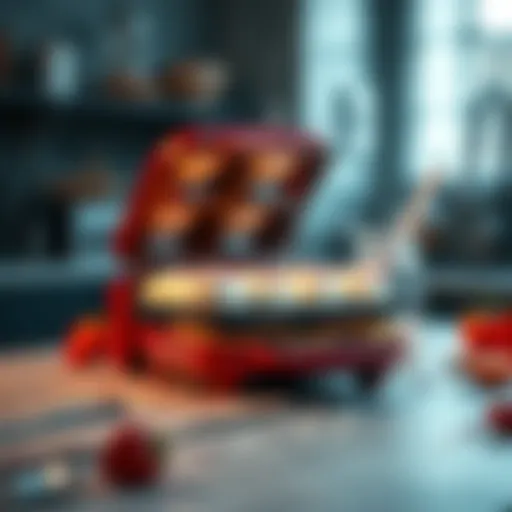A Complete Guide to Selecting Pure Vanilla Extract
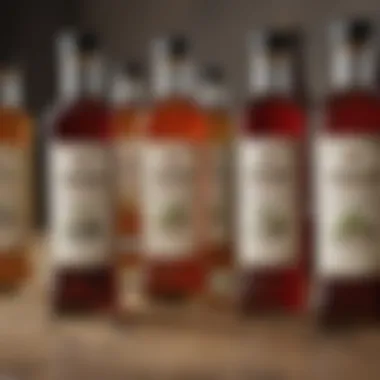

Intro
Pure vanilla extract, a staple in many kitchens, holds a place of honor among flavorings. It is revered not only for its deep, rich flavor but also for its subtle ability to elevate dishes. Whether added to a sweet dessert or used in savory applications, the choice of vanilla profoundly impacts the end result. Making an informed decision when buying pure vanilla extract is essential for both culinary novices and seasoned chefs alike.
In this guide, we will explore everything related to purchasing pure vanilla extract. We will examine the ingredients involved in its composition, methods of preparation, and important dietary considerations. The subsequent sections will cover variations and customizations, as well as address common FAQs to better enhance your understanding of this prized extract.
Ingredients Breakdown
Buying pure vanilla extract involves comprehending its composition and key components. Different ingredients make a direct influence on flavor profile, potency, and overall suitability for culinary uses.
Primary Ingredients
The primary ingredient in pure vanilla extract is natural vanilla bean extractives. These are derived from the cured beans of the Vanilla planifolia orchid, which is primarily grown in Madagascar. A high-quality pure vanilla extract must contain at least 35% alcohol, which acts as a solvent to promote flavor release and preservation.
Optional Ingredients
Some brands may add water or glycerin to their extracts to adjust consistency or sweetness. However, true connoisseurs steer clear of additives unless they are explicitly stated as natural or organic. Reading labels is critical for maintaining purity in what one buys,
Essential Kitchen Tools
When using pure vanilla, a few tools can facilitate its practical application.
- Measuring spoons or cups: to ensure accurate quantities.
- Glass containers: for storing unused ceextract to maintain potency over time.
- Spatulas: effective for incorporating vanilla into various mixtures out preparing baked goods or sauces.
The learning of these ingredients and tools is the groundwork for selecting the right vanilla extract. So much more can be achieved with awareness of these components.
Step-by-Step Preparation
In cooking and baking, using vanilla extract correctly involves more than just pouring it into your recipe. Preparation can really influence flavor intensity.
Prepping the Ingredients
Make sure to use pure types, usually presented in dark glass bottles to protect from light. This also helps in maintaining flavor integrity over time. Always read droplet for the date which signals freshness,
Cooking Techniques and Methods
Regardless of the dish, clean extraction is preferable. Unlike imitation flavors, using pure vanilla extract takes a little extra attention, yet performs magnificently when executed well. Utilize techniques like infusion for liquids or folding in during baking.
Assembly and Presentation Tips
Finally, emphasis should be placed on how dishes incorporating vanilla extract are presented. Remember that appeal enhances enjoyment; this applies even if the vanilla flavor can be subtle. Leverage simple garnishes like whipped cream adorned with fresh berries to enhance visual appeal further.
Dietary Considerations
For contemporary cooks, factors like dietary restrictions are paramount. When selecting or using pure vanilla, understanding potential implications is key.
Gluten-Free Options
Pure vanilla extract is naturally gluten-free. However, as cross-contamination may occur during production, always ensure the brand is certified gluten-free if needed.
Vegetarian and Vegan Substitutes
Those adhering to vegetarian or vegan diets can safely use pure vanilla extract, as it does not contain animal-derived components. It is crucial to check for possible additives in flavored versions that could alter this.
Nutrition Facts & Nutritional Considerations
While flavor is the main draw, remember that pure vanilla is often used in small amounts, so its nutritional impact is minimal. However, it can also have an antioxidant effect that may benefit overall health in larger dishes.
Variations and Customizations
Culinary versatility is at the heart of flavors embedded around pure vanilla extract. By experimenting with various applications, you can heighten your culinary experiences,
Flavor Enhancements
Pairings with spices like cinnamon or nutmeg often bring a certain depth. Floral or fruit suggestions can also help structure your flavor palette as you choose dishes.
Alternative Cooking Methods
Pure vanilla extract finds excellent utility outside traditional baking. You can consider implications of infusion in liquors or creams, same holds true in dressings or reductions, bringing richness in unexpected places.
Pairing Suggestions (Sides, Drinks, etc.
)
The flavor of vanilla pairs well with many ingredients. Babes such as apples or chocolates enhance aesthtics and taste. Likewise, richer beverages such as espresso or chai can also invite a unique experience with the addition of this esteemed extract.
Common Commonly Asked Questionss and Troubleshooting
Understanding common questions can simplify your experience while cooking with pure vanilla extract.
Frequently Asked Questions
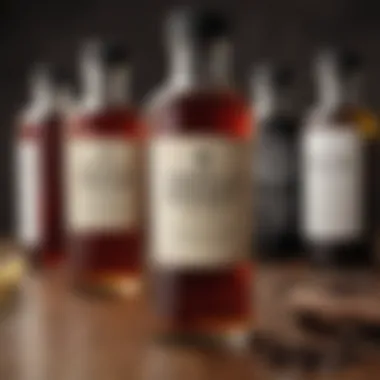

- What of artificial vanilla? Pure vanilla has distinct flavor notes absent in imitation.
- How to store it? Keep it in a cool, dark cupboard or refrigerator to extend browser shelf life.
Common Mistakes to Avoid
Beware using low-quality extracts or using too much. Often only a little bit is needed to evoke desired flavor.
Solutions to Potential Problems
If the extract seems to bland, consider using fresh beans or even increased concentrations to elevate quality.
By following this guide, you will be better equipped to navigate the complexities of purchasing and utilizing pure vanilla extract, ultimately enhancing your culinary endeavors with genuine quality.
Understanding Vanilla Extract
Understanding the complex world of vanilla extract is crucial for anyone looking to enhance their culinary creations. This exploration provides insights into what defines vanilla extract, its different types, and the differences between natural and synthetic varieties. With the market flooded with products claiming to be pure vanilla, having a solid grasp on what to look for can save you time and ensure a superior addition to your kitchen.
What is Pure Vanilla Extract?
Pure vanilla extract is a concentrated liquid flavoring made from vanilla beans. It requires a lengthy extraction process, where the oils and compounds within the beans are dissolved in a solution of alcohol and water. The hallmark of high-quality vanilla extract is its rich aroma and complex flavor profile, attributed to various organic compounds like vanillin. The FDA regulations state that for a product to be deemed 'pure,' it must contain a minimum of 35% alcohol and be derived only from natural sources without imitation flavors. This purity is essential for serious culinary applications.
Types of Vanilla Extract
Vanilla extract is not merely a one-size-fits-all ingredient. It comes in various forms, each offering different flavor nuances:
- Single Fold Extract: Typically the most common type found in stores, offering a standard intensity of flavor.
- Double Fold Extract: Contains twice the concentration of vanilla beans, resulting in a more distinct and intense flavor suitable for professional baking.
- Vanilla Bean Paste: A thick syrup containing vanilla bean seeds, which adds visual appeal while providing the flavor directly from the beans.
- Flavored Extracts: Often combined with other extracts or alcohol, providing unique twists on vanilla, though they may lack the depth of pure flavors.
Natural vs.
Synthetic Vanilla
Understanding the distinction between natural and synthetic vanilla extract can significantly influence your purchasing decisions.
- Natural Vanilla: Sourced primarily from Bourbon and Tahitian vanilla beans, has a rich complexity. It can elevate dishes and desserts with unparalleled depth yet comes at a higher price, notably due to the growing challenges in vanilla farming.
- Synthetic Vanilla: Often referred to as vanillin, it can replicate just the basic flavor note found in real vanilla. Though its cost is significantly lower, for certain culinary experiences, this simplicity does not suffice.
It's important to note that while synthetic vanilla can serve various applications, it lacks the intricate flavor layers that pure vanilla extract offers.
“Choosing pure vanilla is not just a question of flavor. It's about enhancing the integrity and quality of your culinary creations.”
With this fundamental understanding of vanilla extract, one can venture into the deeper waters of sourcing and labeling, further ensuring that their choices align with quality and taste preferences.
The Sourcing of Vanilla
Sourcing vanilla is crucial in determining quality and flavor. It affects how products are made and their pricing. Understanding where vanilla comes from and how it is cultivated helps buyers choose the best extract. This section examines vanilla's cultivation regions, sustainable practices, and how climate affects quality.
Vanilla Cultivation Regions
Vanilla is predominantly grown in tropical areas, where climate and soil types are suitable. The top regions include Madagascar, Mexico, and Tahiti. Madagascar vanilla is most popular and renowned for its creamy flavor profile. Mexican vanilla is known for its rich and deep characteristics. Tahiti, while less common, offers a floral and fruity taste, appealing to some chefs.
Vanilla plants require specific conditions to thrive:
- Temperature: Ideally between 20-30 °C
- Humidity: Should be high, around 70-90%
- Soil: Rich, well-draining soil is essential.
Vanilla growers often utilize hand pollination techniques. Since the vanilla orchid blooms for just one day, proper timing and care are key to successful pollination.
Sustainable Sourcing Practices
Sustainable sourcing is becoming increasingly important in the vanilla industry. Overexploitation and environmental changes have led many growers to adopt eco-friendly practices. Sustainable vanilla sourcing not only preserves the environment but also supports local economies.
Some of these practices include:
- Shade-grown vanilla: Encourages biodiversity and protects local wildlife.
- Crop rotation: This minimizes soil depletion.
- Community support: Ensures fair wages and working conditions for farmers.
Using sustainable methods benefits both producers and consumers, as it contributes to higher quality vanilla with unique flavors.Consumers often gravitate toward brands that support sustainability.
Impact of Climate on Vanilla Quality
Climate directly influences vanilla quality. Variables such as temperature and rainfall can affect growth rates and the overall flavor profile. Ideal conditions yield vanilla beans that are more potent and flavorful.
Periods of drought or excess rain can cause stress to vanilla plants. Insufficient rain can lead to stunted growth, while too much can increase the risk of disease. Temperature changes may also affect the flowering and blooming cycle of the vanilla orchid.
Thus, understanding the impacts of climate is vital for buyers seeking high-grade vanilla extract. Products sourced from regions with stable climates often deliver richer flavors, appealing to both chefs and home cooks.
High-quality vanilla extract often originates from regions with consistent climatic conditions. Selecting from such areas should be a priority for discerning buyers.
Overall, sourcing vanilla involves understanding the environments and practices that affect its quality. This knowledge allows buyers to make informed decisions that will enhance their culinary experiences.
Interpreting Labels
Interpreting labels on products is essential when purchasing pure vanilla extract. The quality and authenticity of vanilla extract can significantly influence the final outcome of culinary creations. Ingredients and formulation are crucial metrics for gauging what you will receive. Misleading or vague terms can result in false expectations.
When selecting vanilla extract, understanding label information can also aid in discerning pure extracts from flavored ones. Sometimes, the labeling can contain specifics that tell you about the quality of the product.
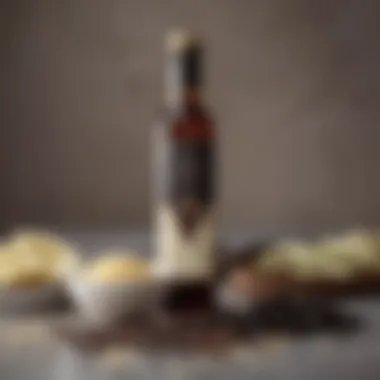

Reading Vanilla Extract Labels
When examining the label on a bottle of vanilla extract, you should first look for products explicitly marked as "pure vanilla extract." If a label indicates "vanilla flavor" or simply "vanilla extract," you may be looking at an inferior product, possibly synthetic. The classification determines if you’re obtaining the genuine flavor that natural vanilla offers.
Essential details that merit attention include:
- Ingredients: All pure vanilla extracts must include vinegar and alcohol, but should explicitly state vanilla beans for quality assurance.
- Origin: Knowing where the vanilla was sourced from provides insight into its quality and flavor nuances.
- Concentration: The label might specify vanillin concentration, primarily when it’s marketed as vanilla extract.
Having this information at hand helps ensure that your culinary needs are adequately met.
Understanding Alcohol Content
Alcohol is a critical component of vanilla extract. Its presence acts not only as a preservative but also serves as a solvent that helps extract desirable flavors and characteristics from beans. Understanding alcohol content is vital, especially for those with specific dietary restrictions or preferences.
Most pure vanilla extracts typically contain about 35% alcohol by volume. However, certain products, like vanilla extracts labeled as “non-alcoholic,” should be examined closely. Often, these alternatives may contain other ingredients to replace the traditional extracts.
Key points include:
- Alcohol helps withdraw the vanilla's flavor and contribute to the shelf-stability of the extract.
- Low-alcohol options are common but may deliver less flavor intensity than standard extracts.
Consumption aspects and ingredient networking must be appropriately understood before discerning if a product aligns with your needs and certain health preferences.
Identifying Additives and Fillers
Noticing the additives and fillers in vanilla extracts is equally crucial. Many commercial products introduce cheaper ingredients to cut costs while providing mediocre flavor. The included fillers may include glucose syrup, caramel, or various additives to stretch the extract's flavor profile and prolong shelf life.
You should be wary of:
- Coloring agents: These may alter flavors and affect your culinary projects.
- High Fructose Corn Syrup: A common extender that can mask genuine vanilla flavors.
- Unnecessary additional flavorings.
Check the complete ingredient list when verifying product quality. A commendable bottle of vanilla extract should have minimal ingredients—vanilla beans, alcohol, and possibly water. If you discover a long list of unrecognizable substances, it’s prudent to reconsider your purchase decision.
Choose quality wisely, and the profound impact on your cooking will resonate in every bite.
Culinary Applications
Culinary applications are typically an aspects where pure vanilla extract shines the most. Its rich flavor and aromatic profile have enamored many in the kitchen. Understanding how to effectively use vanilla extract can dramatically elevate the quality of several dishes. Not only does this enhance the taste of sweet products, but it can bring unpredicted layers to savory items and unexpected beverages. Thus, knowing its applications is a vital part of buying pure vanilla extract.
Using Vanilla Extract in Baking
Baking is perhaps the most common use for pure vanilla extract. Whether one is creating a rich chocolate cake or delicate meringue cookies, usually a little vanilla helps unify the flavors. When you choose to use pure vanilla extract, you bring not just sweetness but also a depth of flavor. Studies suggest that it can mellow the edges of acidic flavors helps them blend beautifully.
Here are some ways vanilla extract enhances baked goods:
- Flavor enhancement: It rounds out the taste, making it more complex.
- Amperage: Elevates basic cookie recipes turning them into something special.
- Moisture retention: Using pure vanilla can influence the moisture level and texture.
Be mindful of how much you utilize; typically, a teaspoon or two is sufficient. This showcases the pure accounting of vanilla without overpowering other flavors.
Vanilla in Savory Dishes
The application of vanilla in savory dishes may seem unconventional to many cooks, but it is very effective. One must approach this fusion carefully. The idea is to lift and broaden flavors instead of simply adding sweetness. When deployed prudently, vanilla extract can intoxicate sauces or glaze designs wonderfully.
For example, adding a splash of vanilla extract into a sauce can create surprising note contrasts within dishes such as:
- Glazed carrots: Pairs well with some more traditional seasonings like thyme or nutmeg.
- Savory risotto: A dash subtly enhances risottos by providing an unexpected flavor dimension.
- Meat marinades: Infusing vanilla in marinades deepens overall notes and provides distinctive precision.
Being judicious will create immensely complex and engaging dishes.
Vanilla in Beverages
Vanilla extract also finds its way into numerous beverages, ensuring they are lush and aromatic. By understanding how to intelligently incorporate this ingredient, one can fashion a variety of drinks ranging from hardcore coffees to sweet juices. Whether it’s a simple vanilla latte or an exquisite cocktail, vanilla elevates enriching experience for your palate.
Consider its role in drinks like:
- Coffee drinks: Boosts flavor in lattes or cappuccinos.
- Smoothies: An easy enhancement, where it mingles with fruits effortlessly.
- Cocktails: Offers a delicious accent; for instance, adding a few drops into a shaken drink.
Using vanilla in beverages serves a contrasting purpose. Not only creates exquisite pairings but allows for a profound aromatic enhancement in drinks.
Using vanilla extract gives endless culinary possibilities, but understanding the various applications can bring out the best in each dish.
Economic Considerations
The economic factors surrounding the purchase of pure vanilla extract cannot be overstated. Vanilla is one of the most labor-intensive crops, and its production is often influenced by fluctuations in the global market and factors such as climate, labor conditions, and trade. Assessment of these economic elements gives consumers the knowledge needed to make informed choices. Understanding the economics of vanilla ensures that nothing is overlooked when it comes to both quality and procurement strategies.
Factors Affecting Vanilla Prices
The price of vanilla extract has risen significantly in recent years, primarily due to supply constraints. A few key factors impact prices directly:
- Growing Conditions: Vanilla plants require specific conditions to thrive. They need shade, humidity, and a suitable temperature. Instances like natural disasters can cause crop losses.
- Labor Challenges: Pollination of vanilla flowers requires skilled labor, which is often in short supply. High labor costs further contribute to price surges.
- Global Demand: Increased demand for quality vanilla in various sectors, include gourmet quality food and cosmetics, puts pressure on available resources at every turn.
A single kilogram of quality vanilla beans can exceed several hundred dollars.
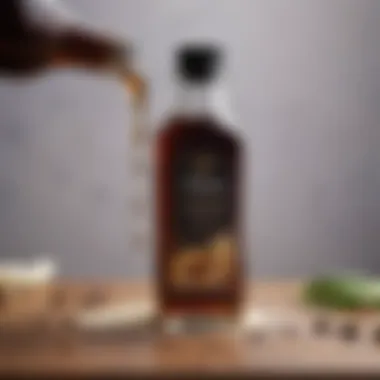

The buying decisions that consumers make are tied directly to their awareness of these economic realities. Educated choices can influence the market positively.
Buying in Bulk vs.
Small Quantities
When purchasing vanilla extract, one of the options consumers face is whether to buy in bulk or in smaller sizes. Each has its advantages.
Benefits of Buying in Bulk:
- Cost Efficiency: Bulk purchases often come with savings. Lower costs can benefit high-volume cooks or businesses.
- Long-Term Supply: For those who utilize vanilla extract regularly, buying in larger quantities ensures consistent availability without the need for frequent shopping trips.
Advantages of Buying Small Quantities:
- Quality Testing: Smaller quantities allow for testing different types without committing, enabling buyers to assess flavor before investing more.
- Storage Concerns: For infrequent users, buying in small bottles can alleviate anxiety concerning shelf life and spoilage.
Ultimately, the decision also depends on individual uses and storage capabilities, presenting an opportunity for strategic purchasing.
DIY Vanilla Extract: An Alternative
Creating your own vanilla extract is becoming a popular alternative that can provide a geater sense of conect with the product. Making homemade extract can offer more than just potential cost savings; it presents several benefits:
- Personal Touch: When you make vanilla extract, you control the quality of the beans, resulting in a product tailored to your preferences.
- Cost Advantage: Buying beans in bulk to create a homemade batch can be cheaper, especially for those using extract frequently.
- Satisfaction in Crafting: The process can be rewarding. Witnessing the transformation of ingredients over time can deepen appreciation for this flavorful ingredient.
To make DIY vanilla extract, all that is needed are a few vanilla beans and a bottle of high-proof alcohol, usually vodka. It’s simple, yet effective, teaching cooks the nuances of flavor through hands-on experience.
Flavor Profiles and Quality
Understanding flavor profiles and quality in vanilla extract is essential for both novice cooks and experienced chefs. The nuances of vanilla flavor can significantly enhance culinary creations. Different strains, production methods, and aging processes contribute to the final flavor profile. Vanilla extracts come with variances, making it vital to know what features to look for to ensure high quality.
How to Assess Vanilla Quality
Assessing vanilla quality involves several steps. Color, smell, and taste are first indicators. A good quality vanilla extract is typically dark brown. However, color alone is not a definitive metric. Next, the aromatic aspect is important. Proper vanilla extract should emit a rich, aromatic smell when the bottle is opened.
A proper tasting technique can also provide great insights. The extract should have depth and complexity—a balance of floral notes and deeper, earthy flavors. Consider using the following checklist:
- Aroma: Does it provide an inviting and robust scent?
- Flavor Balance: Is it sweet, bitter, or complex?
- Aftertaste: Does it linger pleasantly or fade too quickly?
Finding and tasting quality vanilla could involve a bit of experimentation and reliance on reputable sources that provide genuine offerings. Ask sellers about their extraction methods and origins to gauge the quality of their product.
Flavor Intensity in Different Extracts
Flavor intensity can vary dramatically across products. Not all vanilla extracts provide the same experience. There are several factors that contribute to this. Concentration levels are one critical determinant. Pure extracts, especially those labeled with higher vanillin content, will usually be more intense than others, such as imitation extracts.
When it comes to specific varieties, Madagascar, Tahitian, and Mexican vanilla extracts each exhibit distinct flavor intensities:
- Madagascar Vanilla: This one often boasts a rich, creamy flavor.
- Tahitian Vanilla: This option is noted for its fruity, floral qualities.
- Mexican Vanilla: This one tends to have a smoky, spicy essence.
Choosing the right vanilla extract for a specific dish can be guided by flavor intensity. Madagascar vanilla might be best for desserts like ice cream, while Tahitian can complement fruit dishes effectively.
How to Store Vanilla Extract
Proper storage of vanilla extract ensures maximum flavor retention and longevity. Following appropriate methods is essential in preserving both flavor quality and intensity. Store vanilla extract in a cool, dark place—the pantry or cupboard is ideal. Heat and light can degrade the flavor profile over time.
To further safeguard the integrity of your vanilla extract:
- Use dark glass bottles instead of clear ones. They're effective in reducing the influence of light.
- Tightly seal the bottle after each use. Exposure to air can alter flavors.
- Avoid refrigeration. It can encourage the development of unwanted flavors.
A properly maintained bottle of pure vanilla extract can last years, often improving in flavor as it ages.
Remember, the key to enhancing your culinary experience lies in selecting, assessing, and efficiently storing your vanilla extracts.
Culmination: Making Informed Choices
Understanding how to choose pure vanilla extract is essential for any culinary enthusiast. This knowledge allows buyers to appreciate the nuances of flavor and quality. Selecting the right ice cream or cake ingredient can elevate the overall taste experience, ensuring dishes are not only good but exceptionally memorable.
The informed buyer understands what makes a good vanilla extract. They can identify imperfections in labels, discern the differences in quality between products, and opt for ethically sourced options. Furthermore, understanding the flavor profiles enables users to match vanilla extracts to specific recipes, enhancing desired attributes such as smoothness or richness.
Informed choices also shape the market. When buyers prioritize quality over cost, they contribute to a higher demand for premium products. This, in turn, motivates producers to invest in better cultivation practices, leading to improved environmental sustainability. Buyers make not just a personal gain, but influence broader economic and ecological factors.
"Investing in quality vanilla extracts is a testimony to the value of artisanal products and ethical sourcing."
In sum, the importance of making informed choices about vanilla extract cannot be overstated. A deep understanding of the product creates possibilities to elevate culinary abilities while encouraging greater appreciation for quality ingredients.
Summarizing Key Points
In this guide, various important aspects of purchasing pure vanilla extract were covered in detail. Key points include:
- Different Types of Vanilla Extract: Understanding vanilla’s categories increases awareness of what each offers in taste and application.
- Sourcing and Sustainability: Knowing the origins of vanilla contributes to maing environmentally-conscious decisions.
- Label Literacy and Additives: Most quality products have straightforward labeling, helping buyers avoid unwanted additives. Look for certified organic products whenever possible.
- Proper Usage in Culinary Applications: Vanilla is versatile, working well in both sweet and savory recipes.
- Economic Considerations: Keeping an eye on price variations allows buyers leverage; knowing whether buying small or bulk works best for them is critical.
- Flavor Quality Assessment: Learning how to assess flavor intensity aids in making more informed choices effectively.
Every buyer should walk away with a sense of empowerment. They now know the landscape of vanilla extract and how to navigate it for delightful culinary experiences.
Final Tips for Buyers
When heading out to purchase vanilla extract, keep the following advice in mind:
- Research Brands: Look into brands known for high-quality products. Customer reviews can provide additional insight into value and flavor satisfaction.
- Look for authentication: Seek certifications from sources such as organic practices or fair-trade associations, which ensure quality and support ethical farming.
- Store Properly: Trustworthy extracts need the right conditions; ensure proper storage away from excessive light and heat to retain effectiveness.
- Prioritize Freshness: Vanilla extracts can lose flavor over time. Choosing recent bottles often assures stronger taste.
- Experiment Judiciously: Different recipes might require different strengths in flavor; don’t hesitate to sample and adjust according to personal preference.
By incorporating the outlined tips and emphasizing knowledge, buyers enhance the foundation of their culinary expertise through informed choices regarding vanilla extract.





